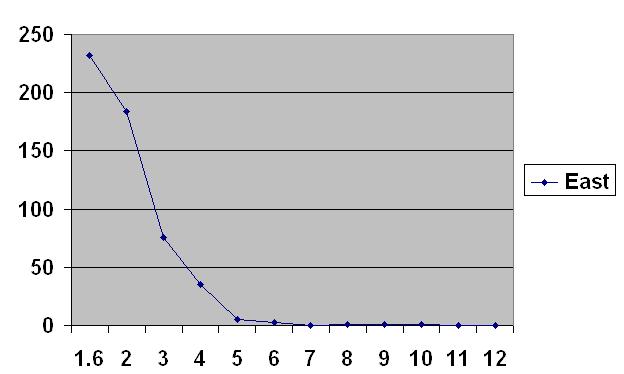Treatment the radioactive liquid wastes derived from nuclear energies cycle to release it into envir
Introduction:
Development in nuclear technology has made the issue of treatment the liquid wastes derived from unclear energies cycle one of the most fundamental problem under consideration in waste producing centers.
Radioactive wastes constitutes a major part of inevitable product in producing electric energy derived from nuclei fission in research radioactive and unclear PowerStation. Radioactive wastes in this installation are produced in liquid, solid and gaseous forms.
These wastes are impurity and polluted with radioactive substances and matters and the most amount of which is gained in nuclear energies cycle in terms of radioactivity content in the process of consumed energies recovery while segregating operation of uranium and plutonium. If these radio isotopes are released into environment or eco systems, they will create irretrievable damages for human and all other organisms.
The aim to accomplish this research plan is to segregate radio-nuclide from the cycle of nuclear energies to keep environment and eco system healthy.
Experimental
Different methods of experimentation are used to experiment any variety of waste depending on their kinds which are produced in nuclear energy cycle. The most important methods of it are those of chemically removal of sediments, ionic exchange, evaporation.
The aim of employing these three methods is radio-nuclide removal from the flow rate of liquid waste. The factors of de contamination in these three methods play important roles because the more a factor of it is high the more it indicates that the experiment has been made well. Ionic exchange method is a very suitable one if no similar non-nuclear ion exists in waste solution. Detergents and complex developers intervene sediment removal operation. Hence it is better to use sediment removal and ion exchange methods for treatment liquid wastes so that we would be able to eliminate from waste how all intervening radio-nuclide that endanger environment and omit their destructive imprints in environment for successive centuries. Experimentation or treatment methods must be implemented in a special and sensitive care and quality control must be exercised on them.
Results and discussion
To control, prevent, maintain and dispose of radio- active wastes in Iran, it is necessary to immediately consider the following problems while obeying nuclear wastes management laws and regulations:
- cementing the concentrated or solidified liquid wastes
- condensing the wastes
- Treatment solid and liquid wastes derived from uranium condensing process.
- Collect, stabilize and maintain closed consumed fountains
- Control, discharge and disposed of wastes in environment.
The findings of uranium treatment in liquid cement which has been made by adding PH is indicated in the following table. Further, the curves showing its modifications and he reduction of its concentration that is carried out by adding PH have been drawn in figure.1
As table 1 shows, the changed concentration of uranium in liquid waste been with the added PH by lime has been reduced from 231.7ppm/ PH=1.6 to 0/3 PPm/ PH=12. And this shows well the test results concerning the removal uranium from liquid waste flow rate by using chemical sediment removal approach.
Table 1. change in uranium concentration in waste and liquid introduced by adding PH with lime
PH | uranium concentration PPm | Standard deviation S.D | |||
1st measurement | 2nd measurement | Third measurement | Mean | ||
1.6 | 237.7 | 230.4 | 227.1 | 231.7 | 3.9 |
2 | 176.8 | 191.5 | 183.2 | 183.8 | 7.4 |
3 | 75.1 | 73.0 | 78.5 | 75.5 | 2.8 |
4 | 33.9 | 38.3 | 34.8 | 34.9 | 1.2 |
5 | 4.9 | 5.3 | 5.2 | 5.1 | 0.2 |
6 | 2.8 | 3.1 | 3.2 | 3.0 | 0.2 |
7 | 0.3 | 0.3 | 0.4 | 0.3 | 0.1 |
8 | 0.7 | 0.8 | 0.9 | 0.8 | 0.1 |
9 | 1.1 | 1.1 | 1.0 | 1.0 | 0.1 |
10 | 0.8 | 1.0 | 0.8 | 0.8 | 0.1 |
11 | 0.3 | 0.2 | 0.4 | 0.3 | 0.1 |
12 | 0.4 | 0.4 | 0.3 | 0.3 | 0.1 |
ph
Fig.1 changed concentration of uranium with added PH happened by lime
References:
1- Handling and Treatment of radioactive aqueous wastes. IAEA-TECDOC-654(1992).
2- Treatment of Low-and Intermediate-level liquid radioactive wastes. IAEA, Technical Reports Series No.236 (1984).
3- B.KAHN, Health physics, 59, 1, 125 (1990)
4- Absorption of Radium and Thorium Wyoming and Utah Uraium mill tailings Solutions. BM/ RI-8396 (1979).
5- Guide to the Safe Handling of Radioactive wastes at nuclear power plants, Technical Reports Series No. 198 (1980).

 گزیده ای از تازه های نجومی و بخش هایی از مقالات، تالیفات و سخنرانی های دکتر سید حسین امیدیانی:
گزیده ای از تازه های نجومی و بخش هایی از مقالات، تالیفات و سخنرانی های دکتر سید حسین امیدیانی: